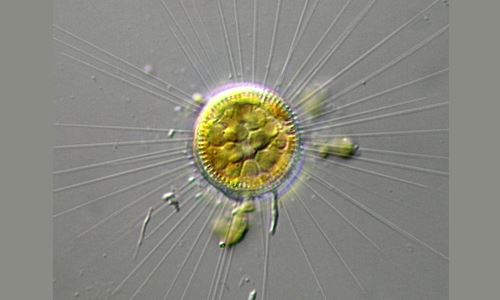The cells are short and drum-shaped, and they can exist individually, form filaments or chains, and occasionally cluster together, held in place by mucilage. These organisms are mainly found in freshwater and are typically planktonic, with two species occasionally occurring in shallow coastal waters, likely as an evolutionary adaptation from brackish waters. The valves are generally circular, although oval and triangular shapes have been discovered in fossil specimens from the Miocene. These valves may exhibit a tangential or concentric undulation on the valve surface. Rows of areolae extend from the center of the valve, and in some cases, they may be absent from the central region, becoming grouped into clusters on the outer part of the valve surface and continuing to the valve edge without interruption. Most species lack a distinctive valve mantle, but some display scattered areolae in the central region. The central area is often adorned with warts, granules, or similar structures, and small warts or spines are sometimes found between the areolae on the valve mantle, forming patterns. The openings of portules, small pores, are flush with the valve surface, often located on hyaline ridges or strips and occasionally surrounded by spines, with one being more prominent. The edge of the mantle often features a banded, grooved thickening. The areolae are poroidal, internally closed off by cribra. Fultoportulae are present in a ring near the valve margin and can also be scattered across the center of the valve. The wall is infolded in the marginal area, with fultoportulae opening on ridges. Sometimes, there are secondary ridges within the folds, which may expand into chambers. Rimoportulae, another type of structure, are present in small numbers and can be found on the folds or at the edge of the central area. Numerous copulae are observed and are split in nature.
